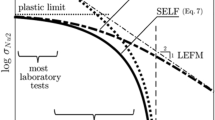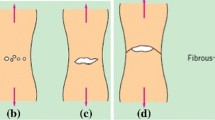Abstract
The sensitivity of the empirical exponent of Bazant's size-effect scaling law on structural geometry is clarified through numerical experiments. For large centre- cracked tension panels, made of a linearly softening material, the best-fitting exponent is 0.90, whereas for large edge-cracked panels it is 0.75. For edge-cracked panels, the value of the exponent increases as a function of increasing crack-length-to-width-ratio. The results indicate that with structures of brittleness numbers below unity, reliable predictions of strength require the size-effect scaling law to be fitted for any particular structural geometry.
Similar content being viewed by others
References
Bazant, Z.P. (1984). Size effect in blunt fracture: concrete, rock, metal. Journal of Engineering Mechanics 110, 518-535.
Bazant, Z.P. (1986). Fracture mechanics and strain-softening of concrete. Proceedings, U.S.-Japan Seminar on Finite Element Analysis of Reinforced Concrete Structures (Tokyo, May 1985). American Society of Civil Engineers, New York, 121-150.
Bazant, Z.P. (2000). Size effect. International Journal of Solids and Structures 37, 69-80.
Bazant, Z.P. and Planas, J. (1998). Fracture and size effect in concrete and other quasibrittle materials. CRC Press.
Bazant, Z.P., Kim, J.-J. H., Daniel, I.M., Becq-Giraudon, E. and Li, G. (1999). Size effect on compression strength of fiber composites failing by kink band propagation. International Journal of Fracture 95, 89-101.
Carpinteri, A. (1994a). Scaling laws and renormalization groups for strength and toughness of disordered materials. International Journal of Solids and Structures 31, 291-302.
Carpinteri, A. (1994b) Fractal nature of material microstructure and size effects on apparent mechanical properties. Mechanics of Materials 18, 89-101.
Carpinteri, A., Chiaia, B. and Ferro, G. (1994). Multifractal nature of material microstructure and size effect on nominal tensile strength. Fracture of Brittle Disordered Materials: Concrete, Rock and Ceramics (Edited by G. Baker and B. L. Karihaloo). E&FN Spon, London, 21-34.
Carpinteri, A. and Chiaia, B. (1995). Multifractal scaling law for the fracture energy variation of concrete structures. Fracture mechanics of concrete structures (Edited by F.H. Wittmann). Aedificatio Publishers, Freiburg, Germany, 581-569.
Elices, M. and Planas, J. (1992). Size effect in concrete structures: an R-curve approach. Applications of Fracture Mechanics to Reinforced Concrete (Edited by A. Carpinteri). Elsevier Applied Science, London, 169-200.
Hillerborg, A., Modéer, M. and Petersson, P.-E. (1976). Analysis of crack formation in concrete by means of fracture mechanics and finite elements. Cement and Concrete Research 6, 773-782.
Kärenlampi, P. and Yu, Y. (1997). Fiber properties and paper fracture-fiber length and fiber strength. 11th Fundamental Research Symposium, Cambridge, England, September 23-26, 1997, 521-545.
Östlund, S. and Nilsson, F. (1993). Cohesive modelling of process regions for cracks in linear elastic structures-fundamental aspects. Fatigue and Fracture of Engineering Materials and Structures 16, 215-235.
Östlund, S. (1995). Fracture modelling of brittle-matrix composites with spatially dependent crack bridging. Fatigue and Fracture of Engineering Materials and Structures 18, 1213-1230.
Planas, J. and Elices, M. (1991). Nonlinear fracture of cohesive materials. International Journal of Fracture 51, 139-157.
Planas, J. and Elices, M. (1992). Asymptotic analysis of a cohesive crack: 1. Theoretical background. International Journal of Fracture 55, 153-177.
Planas, J., Guinea, G.V. and Elices, M. (1995). Rupture modulus and fracture properties of concrete. Fracture mechanics of concrete structures (Edited by F.H. Wittmann). Aefiticatio Publishers, Freiburg, Germany, 95-110.
Planas, J., Guinea, G.V. and Elices, M. (1997). Generalized size effects equation for quasibrittle materials. Fatigue and Fracture of Engineering Materials and Structures 20, 671-687.
Swartz, S.E., Lu, L.W. and Tang, L.D. (1988). Mixed-mode fracture toughness testing of concrete beams in three-point bending. Materials and Structures 21, 33-40.
Tada, H. (1985). The Stress Analysis of Cracks Handbook. Paris Productions, St. Louis, Missouri, U.S.A.
Tryding, J. and Gustafsson, P.-J. (1996). Localized damage and fracture in paper. 1996 International Paper Physics Seminar, Stockholm, Sweden, 144-150.
Tryding, J. (1996). In-plane fracture of paper. Lund University, Division of Structural Mechanics, Report TVSM-1008.
Ungsuwarungsri, T. and Knauss, W.G. (1988). A nonlinear analysis of an equilibrium craze: Part II - Simulations on craze and crack growth. Journal of Applied Mechanics 55, 42-58.
Van Vliet, M.R.A. and Van Mier, J.G.M. (1999). Effect of strain gradients on the size effect on concrete in uniaxial tension. International Journal of Fracture 95, 195-219.
Weibull, W. (1939). A statistical theory on the strength of materials. Ingenjörsvetenskapsakademins handlingar, 151, 5-45.
Wu, X.-R. and Carlsson, J. (1991). Weight Functions and Stress Intensity Factor Solutions. Pergamon Press, Oxford, U.K.
Author information
Authors and Affiliations
Rights and permissions
About this article
Cite this article
Östlund, S., Kärenlampi, P. Structural geometry effect on the size-scaling of strength. International Journal of Fracture 109, 141–151 (2001). https://doi.org/10.1023/A:1011045510152
Issue Date:
DOI: https://doi.org/10.1023/A:1011045510152




